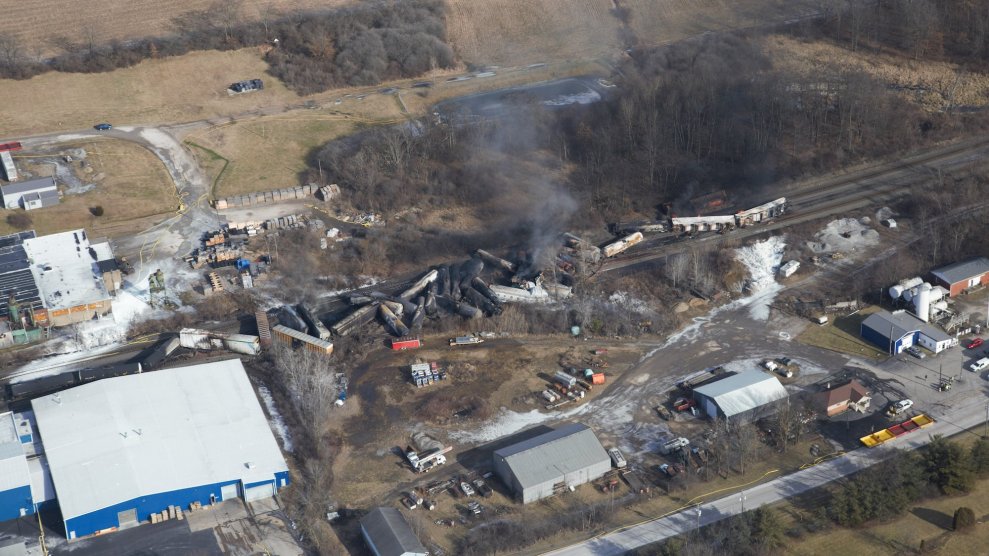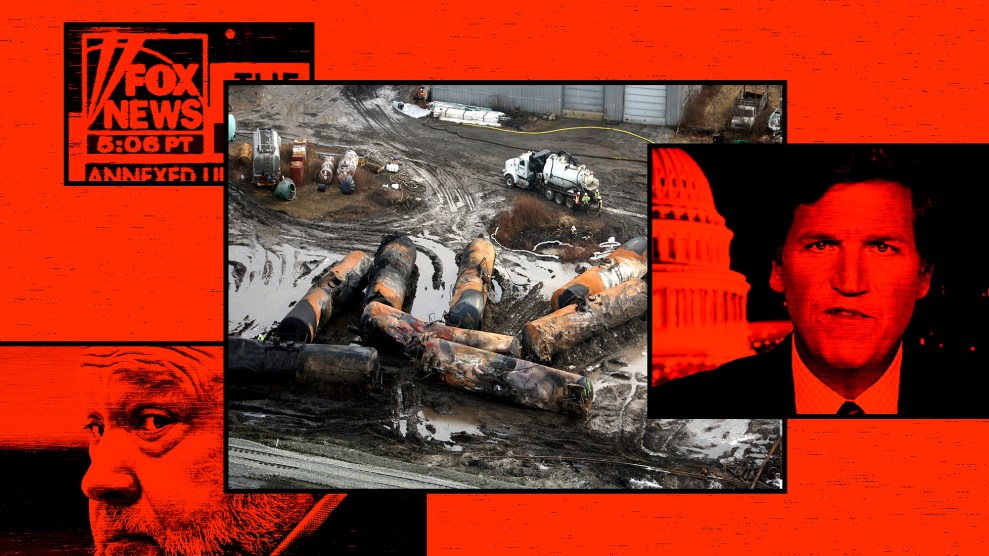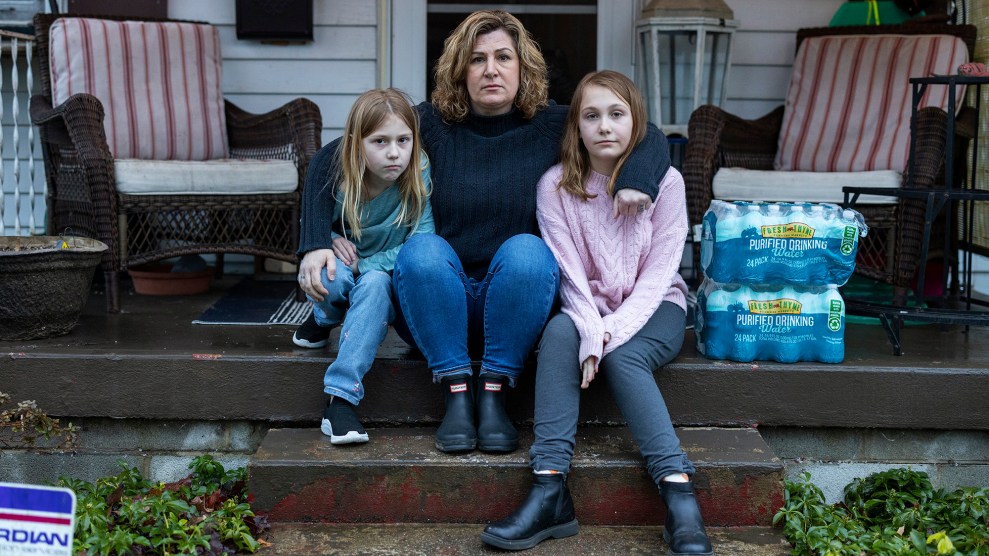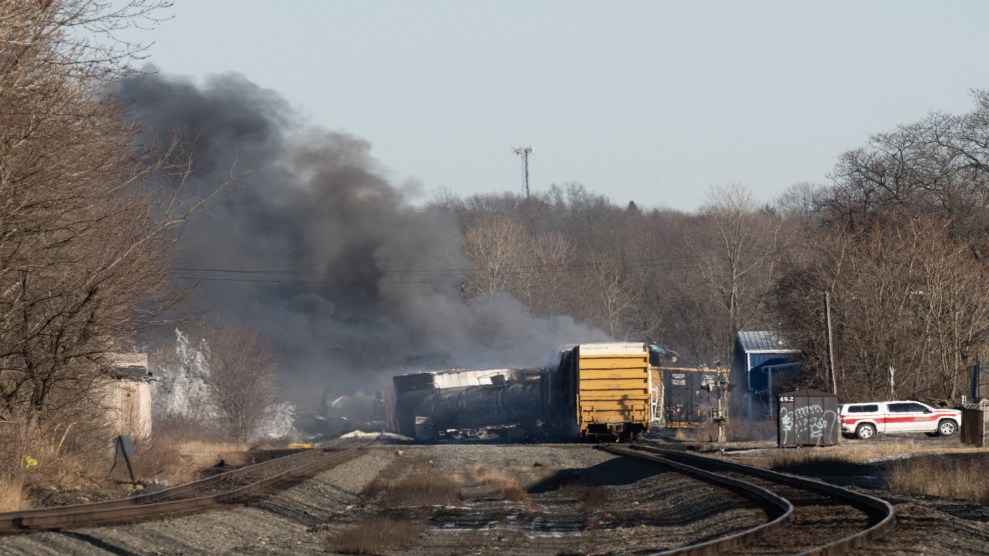
An aerial view of the Norfolk Southern freight train that was carrying toxic chemicals that derailed in East Palestine.NTSB/Zuma
This story was originally published by Inside Climate News and appears here as part of the Climate Desk collaboration.
The Environmental Protection Agency announced last week that vinyl chloride would be among five chemicals to begin the process for risk evaluation prioritization under the Toxic Substances Control Act, or TSCA, an early step toward potentially banning the chemical.
The news comes after environmental groups campaigned this summer for the chemical to be banned, visiting EPA offices in Washington in July and gathering thousands of petition signatures. Vinyl chloride is a colorless gas that is used to make PVC, a common material in construction products like flooring, siding, pipes, and roofing. Vinyl chloride has been known as a human carcinogen since the 1970s.
“The announcement is very significant because EPA announced that they’re only going to look at five chemicals for a new evaluation,” said Judith Enck, a former EPA regional administrator and the president of Beyond Plastics, an organization working to end plastic pollution.
Enck was part of the team that traveled to Washington this summer. She brought a large vinyl rubber ducky to the EPA meeting to illustrate the fact that PVC is used to make children’s toys.
“We are pleased that EPA has taken the first step in a comprehensive scientific review, and we are hopeful that it concludes with the decision to ban vinyl chloride because there is more than enough science on this chemical to warrant a ban,” she said.
In February, vinyl chloride made headlines around the world when a train carrying the highly flammable substance derailed in East Palestine, Ohio. When officials conducted a vent and burn of the leaking vinyl chloride, billowing, black clouds could be seen for miles on the horizon, and hundreds of people had to be evacuated from their homes; months later, some of them are still displaced.
Residents in both Pennsylvania and Ohio, as well as investigators at the scene, later complained about health effects such as headaches, nausea, nosebleeds, and coughing. The accident highlighted the ways vinyl chloride’s sprawling supply chain in the United States poses risks not only to workers in the facilities where vinyl chloride and PVC are manufactured, but to anyone who lives near an active rail line. The Norfolk Southern train involved in the East Palestine disaster originated in Texas and was heading to New Jersey.
The EPA’s new list is just one phase in a years-long assessment process the agency must follow under the Toxic Substances Control Act. Following Thursday’s announcement and the official publication of the list, there will be a 90-day public comment period inviting the submission of information about vinyl chloride.
If vinyl chloride is selected for “high priority” designation at the end of this phase, which can last between nine and 12 months, EPA will embark on a more comprehensive review of vinyl chloride’s risks to the general public, the environment and workers, an evaluation process that can take up to three-and-a-half years. If “unreasonable risk” is found, the agency moves to the “risk management” phase, lasting up to two years, to decide how to impose restrictions on the chemical.
Some advocates are worried about the potential for political intervention in EPA’s eventual decision and whether the agency will act to ban vinyl chloride, place additional restrictions on it—or do nothing at all—with a Republican in the White House in 2025.
“Quite honestly, I think a lot of that will be affected by whoever is president at the time,” Enck said. “You would think that these are just scientific decisions, but whoever is in power definitely has influence.”
“If EPA follows the science and the law and looks at all the routes of exposure, they will be led to the conclusion that vinyl chloride is far too dangerous to make or use and should be banned,” said Liz Hitchcock, the director of the federal policy program at Toxic-Free Future, an environmental health nonprofit that has conducted research on vinyl chloride and PVC manufacturing and its implications for environmental justice.
Vinyl chloride has been banned for use in aerosols in the U.S. since 1974, and EPA’s press release about the announcement notes that health concerns about vinyl chloride in the 1970s prompted the passage of the original version of the TSCA. PVC packaging is banned or restricted in Canada, Spain, South Korea and the Czech Republic.
Some companies, including Apple, IKEA, and Nike, have already committed to phasing out PVC in their products, and environmentalists are hopeful that other corporations might follow their example in the future, especially those that manufacture building materials made of PVC.
PVC is on the U.S. Plastics Pact’s list of 11 Problematic and Unnecessary Materials, which members “will take measures to eliminate by 2025.” The Pact’s membership list includes companies such as Aldi, Walmart, Unilever, Nestle and General Mills.
In a press release, the Vinyl Institute, an industry trade group, said its members were “fully prepared to work with the EPA” and “to serve as a collaborative resource for the Agency.”
“This is an opportunity to correct any misunderstanding about the regulation of vinyl chloride manufacturing and the safety of PVC products,” said Ned Monroe, president and CEO of the Vinyl Institute. “We believe this risk evaluation will further assure that the production of vinyl chloride and use of PVC products are safe. Manufacturers of vinyl chloride adhere to some of the most stringent safety and environmental regulations in the chemical industry.”
Jess Conard, a resident of East Palestine who now works as an advocate for Beyond Plastics, noted that more than 14 million people in West Virginia, Ohio and Pennsylvania live within one mile of a railroad track. “If you live, work or attend school along the rail line, you and your loved ones are at risk for the same fate as East Palestine, Ohio,” Conard said in a statement. “We cannot continue to put our children at risk. It is time to ban vinyl chloride.”













